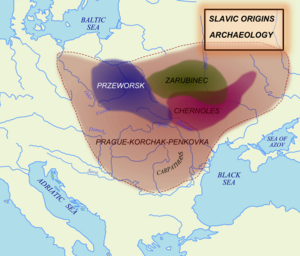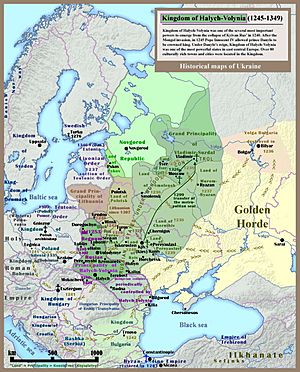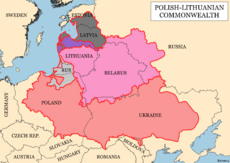History of Ukraine facts for kids
Ukraine, a country in Eastern Europe, has a very long and interesting history! For thousands of years, its lands have been a crossroads for many different cultures and empires. From ancient times, people have lived here, shaping the continent's history.
In ancient times, Ukraine was part of Scythia, a land where nomadic groups like the Scythians lived. Later, during the "Migration Period" when many groups moved across Europe, it was settled by the Goths. Ukraine was also a place where the early Slavs began to spread out.
A very important part of Ukraine's history began with the medieval state called Kievan Rus'. This powerful nation grew in the Middle Ages but eventually broke apart by the mid-12th century.
Later, in the 14th and 15th centuries, different parts of Ukraine were ruled by four big powers: the Golden Horde (Mongols), the Crimean Khanate, the Grand Duchy of Lithuania, and the Crown of the Kingdom of Poland. The last two joined together to form the Polish–Lithuanian Commonwealth. The Ottoman Empire also became a major power around the Black Sea, controlling areas like the Crimean Khanate.
In 1648, the Cossacks, who were brave warriors, rebelled against the Polish–Lithuanian Commonwealth. Their leader, Bohdan Khmelnytsky, signed an agreement with Russia in 1654. This led to a long war between Russia and Poland. Eventually, in 1686, eastern Ukraine (east of the Dnieper River) came under Russian rule.
During the Great Northern War in the early 1700s, a Cossack leader named Ivan Mazepa allied with Sweden against Russia. But after a big battle, the Cossacks lost much of their power. By the late 1700s, the Cossack Hetmanate (their state) was gone, and the Zaporozhian Sich (their main stronghold) was destroyed. After Poland was divided up by its neighbors, the Russian Empire and Habsburg Austria controlled all the lands that are now Ukraine for over a hundred years. During the 1800s, a strong sense of Ukrainian nationalism began to grow.
The 20th century brought many changes. After the Russian Revolution in 1917 and World War I, Ukraine went through a chaotic period of wars. The Ukrainian People's Republic tried to become independent, but after the Ukrainian–Soviet War, the Bolsheviks (a communist group) took control. They formed the Ukrainian Soviet Socialist Republic, which became one of the founding parts of the Soviet Union in 1922.
In the 1930s, millions of people in Ukraine, mostly farmers, died in a terrible famine caused by Soviet policies. This event is known as the Holodomor.
During World War II, Nazi Germany invaded the Soviet Union, and Ukraine was occupied. Some Ukrainians fought for independence against both Germany and the Soviet Union, while others helped the Nazis, especially in the killing of Jews. After the war, Ukraine's territory grew, and in 1954, Crimea was transferred from Russia to Ukraine.
Ukraine finally became independent again when the Soviet Union broke apart in 1991. This led to a period of economic challenges. In 2013, a major political crisis began when President Viktor Yanukovych decided not to sign an agreement with the European Union, choosing closer ties with Russia instead. This led to the Euromaidan protests and the "Revolution of Dignity." Yanukovych was removed from power in February 2014.
Soon after, in February 2014, the Russo-Ukrainian War began when Russian forces entered Crimea. Crimea was then taken over by Russia. This was followed by fighting in eastern Ukraine, known as the War in Donbas. This conflict continued until February 24, 2022, when Russia launched a large-scale invasion of Ukraine.
Ancient Times
People have lived in Ukraine for a very long time, even in prehistory. Evidence of early humans, like Neanderthals, has been found at sites like Molodova, dating back about 45,000 years. The earliest signs of modern humans are from 32,000 BC in the Buran-Kaya cave in the Crimean Mountains.
Early Cultures and Nomads
In the late Stone Age (Neolithic period), the Cucuteni-Trypillian Culture thrived from about 4500 to 3000 BC. These people lived in the western part of Ukraine. Further east, during the Copper Age, was the Sredny Stog culture, followed by the early Bronze Age Yamna culture (also called "Kurgan" culture) from the Pontic steppes.
During the Iron Age, nomadic groups like the Cimmerians, Scythians, and Sarmatians lived in Ukraine. The Scythian kingdom existed here from 750 to 250 BC. Ancient Greek cities were also founded along the Black Sea coast, like Tyras and Olbia, and they continued to be important Roman and Byzantine cities until the 6th century AD.
In the 3rd century AD, the Goths arrived in Ukraine, calling the area Oium. They stayed until the Huns arrived in the 370s. North of the Goths, the Kyiv culture flourished from the 2nd to 5th centuries.
The Rise of Early Slavs
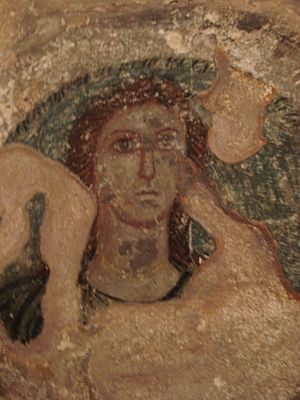
After the Huns and Goths left, a power vacuum was created. This allowed the Early Slavs to expand across much of Ukraine starting in the 5th century. They then spread further into the Balkans in the 6th century.
While we don't know exactly where the Early Slavs came from, many theories suggest they might have originated near Polesia. In the 5th and 6th centuries, a group called the Antes Union lived in Ukraine. They are thought to be ancestors of modern Ukrainians, including groups like the White Croats and Polans. Slavs from Ukraine also migrated south to form many South Slavic nations and north to form groups ancestral to the Russians.
Middle Ages
Early States and Empires
In the 7th century, the land of modern Ukraine was the heart of the state of the Bulgars, often called Old Great Bulgaria. Later, most Bulgar tribes moved away, and the remaining parts of their state were taken over by the Khazars.
The Khazars were a semi-nomadic people from Central Asia who founded a kingdom near the Caspian Sea. Their kingdom included parts of Crimea, eastern Ukraine, and southern Russia. The Khazars created a safe trading environment, known as Pax Khazarica, which allowed long-distance trade to happen safely. This attracted traders like the Vikings, who would later establish Kyivan Rus'.
Kyivan Rus'

The state of Kyivan Rus' began around 880 AD when a Viking nobleman named Oleh the Wise established a principality in the city of Kyiv. Kyiv was already an old city, and historians believe Slavic people lived there from the late 5th century. Kyiv might have paid tribute to the Khazars before Oleh conquered it.
Historians also think Kyiv was a meeting point for many different groups, including Slavs, Vikings, and Finno-Ugric peoples. Slavic groups native to Ukraine included the Polans, Drevlyans, and Severians.
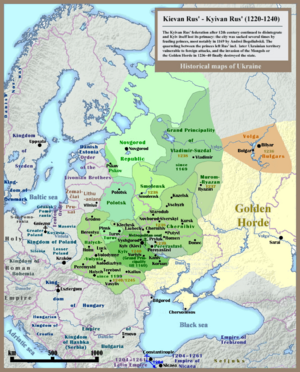
In the 10th and 11th centuries, Kyiv became one of Europe's richest trading centers, and the Kyivan Rus' empire grew steadily. At first, people worshipped Slavic gods, but Volodimer I converted to Orthodox Christianity in the 980s. This connected Kyivan Rus' to the powerful Byzantine Empire. The reign of Yaroslav the Wise (1019–1054) is seen as the golden age of Kyivan Rus', making it one of the most prosperous and powerful empires in Christendom.
Kyivan Rus' was not a single, centralized state but rather a collection of smaller principalities ruled by members of the Rurik dynasty. In later Middle Ages, it was known in Europe as Ruthenia.
Christianization of Rus'
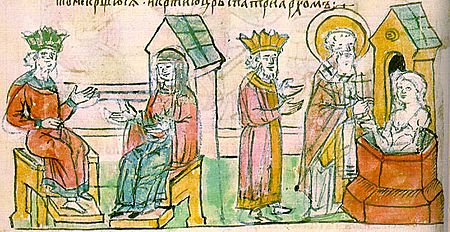
Christianity had reached parts of Ukraine even before the first major church council in 325 AD, especially along the Black Sea coast. However, the official acceptance of Christianity in Rus' happened in 988. The main person who promoted the Christianization of Kievan Rus' was Grand-Duke Vladimir the Great, whose grandmother, Princess Olga, was already a Christian.
Decline of Kyivan Rus' and Mongol Invasion
Conflicts among the different principalities of Rus' led to its decline starting in the 12th century. Kyiv was attacked by other princes in 1169 and later by Cuman and Mongol raiders in the 12th and 13th centuries. In 1240, the Mongols sacked Kyiv, causing many people to flee. After this, all the principalities in present-day Ukraine became dependent on the Mongols from 1239 to 1240.
Galicia-Volhynia
After Kyivan Rus' fell, a new state called the Kingdom of Galicia–Volhynia emerged in parts of modern Ukraine. This region was home to several Slavic tribes. It was united by Roman the Great (1197-1205), who even briefly ruled Kyiv.
After Roman's death, there was a period of trouble until his son Daniel took the throne in 1238. Daniel rebuilt his father's state and even controlled Kyiv. He paid tribute to the Mongol khan, who made him responsible for collecting tribute from other Rus' princes. In 1253, a papal delegation crowned him "King of Rus'."
Polish and Lithuanian Rule
In the 14th century, Poland and Lithuania fought against the Mongols. Eventually, most of Ukraine came under Polish and Lithuanian rule. Lithuania took control of areas like Volhynia and Kyiv. The rulers of Lithuania then called themselves rulers of Rus'.
After the fall of Kyivan Rus' and Galicia–Volhynia, Ukrainian political, cultural, and religious life continued under Lithuanian control. Ukrainian nobles became part of the Lithuanian government. While Lithuanian was the language of the rulers, Latin, Old Church Slavonic, and Ruthenian (an early form of Ukrainian) were used for writing. Later, Polish became more common.
Eventually, Poland took control of the southwestern region. After Poland and Lithuania united, Poles, Germans, Lithuanians, and Jews moved to the region. This led to Ukrainians losing power and being forced into central Ukraine. This also caused tension and oppression against Ukrainians.
In 1490, a series of rebellions against Polish oppression began, led by Ukrainian Petro Mukha. These rebellions, supported by the Moldavian prince Stephen the Great, captured several cities and reached as far west as Lviv.
The decline of the Golden Horde in the 15th century led to the creation of the Crimean Khanate. This state controlled the Black Sea shores and southern steppes of Ukraine. Until the late 18th century, the Crimean Khanate was involved in a large slave trade with the Ottoman Empire, exporting about 2 million slaves from Russia and Ukraine. It remained under Ottoman control until Russia took it over in 1783.
Early Modern Period
Polish–Lithuanian Commonwealth
After the Union of Lublin in 1569, which created the Polish–Lithuanian Commonwealth, Ukraine came under Polish administration. This period saw a lot of new settlements and the founding of many new cities and villages. Connections between different Ukrainian regions, like Halych and Volhynia, also grew.
New schools spread ideas of the Renaissance. Many Polish peasants moved to the area and mixed with the local population. During this time, most Ukrainian nobles adopted Polish culture and converted to Catholicism. However, most Ukrainian-speaking peasants remained in the Eastern Orthodox Church, which led to social tension.
Ukrainian peasants who escaped being forced into serfdom (a type of forced labor) became known as Cossacks. They were famous for their fierce fighting spirit. Some Cossacks were hired by the Commonwealth as soldiers to protect its borders from Tatars or fought in wars abroad. Despite their military usefulness, the Commonwealth, which was controlled by its nobles, refused to give the Cossacks much freedom. Instead, they tried to turn most Cossacks into serfs. This led to more and more Cossack rebellions against the Commonwealth.
The Cossack Era
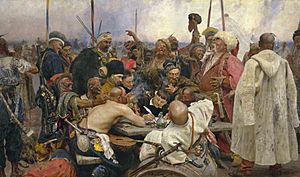
The 1648 Ukrainian Cossack rebellion, known as the Khmelnytsky Uprising, greatly weakened the Polish–Lithuanian Commonwealth. This rebellion started a difficult period called "the Ruin" in Ukrainian history. The new Cossack state, the Cossack Hetmanate, which is seen as an early form of Ukraine, found itself in a struggle with the Ottoman Turks, the Polish–Lithuanian Commonwealth, and the Tsardom of Russia.
To escape the Polish–Lithuanian Commonwealth, the Zaporozhian Host (a Cossack group) sought protection from Russia in 1654. This agreement was called the Pereiaslav Agreement. The Commonwealth then tried to make a deal with the Cossacks by signing the Treaty of Hadiach in 1658. However, after thirteen years of continuous war, this agreement was replaced by the 1667 Polish–Russian Truce of Andrusovo. This truce divided Ukrainian territory between the Commonwealth and Russia. Under Russia, the Cossacks initially kept some freedom in the Hetmanate. They also had a semi-independent republic in Zaporizhzhia.
In 1686, the main church in Kyiv, the Metropolitanate of Kyiv, was taken over by the Moscow Patriarchate.
Russian Empire and Austria-Hungary
Over the next decades, Russian rule in central Ukraine slowly replaced the Cossacks' "protection." Cossack uprisings against Russian authorities eventually stopped by the late 18th century. After the Partitions of Poland in 1772, 1793, and 1795, the far west of Ukraine came under Austrian control, while the rest became part of the Russian Empire. As a result of wars with the Ottoman Empire, their control over south-central Ukraine also ended.
Ukrainian writers and thinkers were inspired by the nationalistic spirit spreading across Europe. They wanted to revive Ukrainian language and culture and create a Ukrainian nation-state. This movement was called Ukrainophilism.
Russia, fearing that Ukrainians would want to separate, placed strict limits on the Ukrainian language and culture. In 1863, a rule called the Valuev Circular banned Ukrainian in religious and educational books. In 1876, the Ems Ukaz completely outlawed Ukrainian-language publications, plays, and public readings, and banned its use in schools. These policies, known as Russification, caused many Ukrainian intellectuals to move to Western Ukraine.
Life for Ukrainians was different under the Austrian Empire. Most of the elite in Galicia (Western Ukraine) were Austrian or Polish, and Ukrainians were mostly peasants. During the 19th century, some Slavic people in Austria supported Russia, but the arrival of Ukrainian intellectuals fleeing Russian oppression helped strengthen the Ukrainian nationalist movement. When World War I began, those who supported Russia were rounded up by Austrian forces and held in a concentration camp.
Modern History
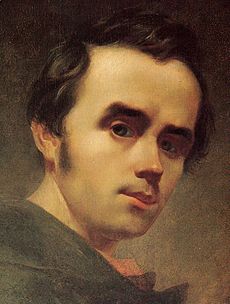
The idea of Ukraine as a nation and Ukrainians as a distinct nationality began to grow in the mid-18th century. This followed peasant revolts and the eventual division of the Polish–Lithuanian Commonwealth. Galicia became part of the Austrian Empire, and the rest of Ukraine joined the Russian Empire.
Most of Ukraine came under the Russian Empire during the reign of Catherine the Great. The Crimean Khanate was taken over by Russia in 1783. In 1793, right-bank Ukraine was also annexed by Russia during the Partitions of Poland.
Russia, fearing separatism, put strict limits on attempts to promote the Ukrainian language and culture, even banning its use and study. This led some Ukrainian intellectuals to move to Western Ukraine, while others adopted a Russian identity.
The 19th Century
Under Alexander I (1801–1825), Russia's presence in Ukraine was mainly military and bureaucratic. But by the reign of Nicholas I (1825–1855), Russia had established a centralized government in Ukraine. After putting down a rebellion in 1830, the Russian government enforced Russification policies in Right-bank Ukraine.
The 2.4 million Ukrainians under the Habsburg Empire lived in eastern Galicia and were mostly peasants. The nobles in Galicia were mainly Poles or Polonized Ukrainians. This region was one of the poorest in Europe.
A rise in national awareness happened in the 19th century. More common people and peasants became involved in the movement to improve national rights and social justice. The 1861 emancipation (when serfs were freed) greatly affected Ukrainians, as 42% of them were serfs. By the late 19th century, heavy taxes, fast population growth, and lack of land made many peasants poor. However, the Ukrainian steppe regions produced a large amount of wheat and sugar for the empire. Later, industrialization arrived with the first railway in 1866. Ukraine's economy became part of the Russian imperial system, and its cities grew a lot.
The 20th Century
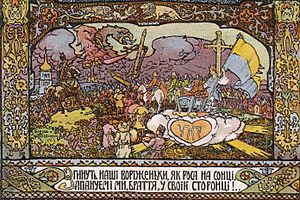
After the February Revolution in Russia in 1917, Ukraine tried to break free. From 1917 to 1920, several groups tried to create independent Ukrainian states. This was a very chaotic time with revolutions, civil wars, and many different groups fighting for power. Kyiv changed hands five times in less than a year!
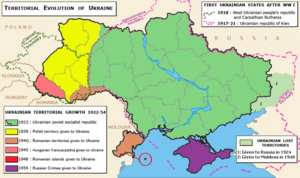
The Ukrainian War of Independence (1917–1921) led to the creation of the Ukrainian Soviet Socialist Republic. This republic quickly became part of the Soviet Union.
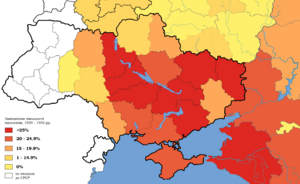
The Soviet famine of 1930–1933, known as the Holodomor, caused millions of deaths in the Soviet Union, mostly Ukrainians.
Second World War
World War II began in September 1939 when Germany and the Soviet Union invaded Poland. The Soviet Union took most of Eastern Poland. In 1941, Nazi Germany and its allies invaded the Soviet Union. Some Ukrainians initially saw the German soldiers as liberators from Soviet rule, while others formed a partisan movement to fight them. Some Ukrainian nationalists fought against both Soviet and Nazi forces, while others helped the Germans. About 1.5 million Jews were killed by the Nazis during their occupation of Ukraine.
After World War II, the Ukrainian SSR was allowed to act as a separate country in some ways, even while remaining part of the Soviet Union. For example, it became one of the founding members of the United Nations. In 1954, the Crimean Oblast was transferred from Russia to the Ukrainian SSR.
Independence
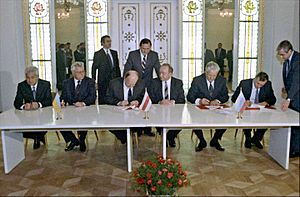
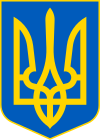

When the Soviet Union collapsed in 1991, Ukraine became an independent state. This was made official by a referendum in December 1991, where over 90% of Ukrainian citizens voted for independence. The Soviet Union officially ended on December 26, 1991.
On December 1, 1991, Ukrainians elected Leonid Kravchuk as their first president. During his time, the Ukrainian economy faced many challenges. The next president, Leonid Kuchma (1994–2005), saw the economy recover.
Orange Revolution and Euromaidan
In 2004, there was a presidential election with two main candidates: Viktor Yanukovych, who wanted closer ties with Russia, and Viktor Yushchenko, who wanted Ukraine to look more towards Europe. Yanukovych was initially declared the winner, but Yushchenko and his supporters claimed the election was unfair. This led to massive street protests in Kyiv and other cities, known as the Orange Revolution. The Supreme Court ordered a new election, and Yushchenko won.
During Yushchenko's presidency, relations with Russia were often tense as he sought closer ties with the European Union. In 2005, a dispute over natural gas prices with Russia caused problems for many European countries.
In the 2010 Ukrainian presidential election, Viktor Yanukovych won. During his presidency (2010–2014), he was accused of trying to centralize power.
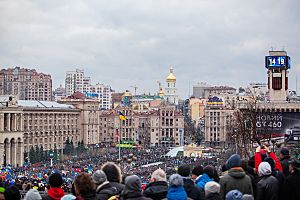
In November 2013, President Yanukovych decided not to sign an important agreement with the European Union, choosing closer ties with Russia instead. This decision sparked huge protests in Kyiv, known as Euromaidan. Protesters set up camps in Independence Square. In December 2013 and January 2014, protesters began taking over government buildings. Battles between protesters and police in February 2014 resulted in about 80 deaths.
Following the violence, the Ukrainian parliament voted to remove Yanukovych from power on February 22, 2014. He fled Kyiv.
Western Integration
On January 1, 2016, Ukraine joined a free trade area with the EU. Ukrainian citizens were granted visa-free travel to the Schengen Area in 2017. Ukraine has been working to join the European Union and NATO.
In 2019, the Constitution of Ukraine was changed to include norms about Ukraine's strategic goal of joining the European Union and NATO.
On April 21, 2019, Volodymyr Zelenskyy was elected president. His party won a majority in parliament, allowing them to form a government.
In 2020, Ukraine, Lithuania, and Poland created the Lublin Triangle initiative to improve cooperation and help Ukraine join the EU and NATO. In 2021, the Association Trio was formed with Georgia and Moldova to strengthen cooperation with the EU. At the NATO summit in June 2021, leaders confirmed that Ukraine would become a member of the Alliance.
Russo-Ukrainian War
In March 2014, Russia took over Crimea. Although a referendum was held, it was organized under Russian military occupation and was called illegal by the European Union and the United States.
This was followed by pro-Russian unrest in eastern and southern Ukraine. In April 2014, separatists declared the Donetsk People's Republic and Lugansk People's Republic. Fighting between the Ukrainian army and pro-Russian forces escalated into the war in Donbas. By December 2014, over 6,400 people had died, and many became displaced or fled to other countries. Political and economic reforms began during this time. Petro Poroshenko was elected president in May 2014.
On February 2, 2021, a presidential decree banned several pro-Russian TV channels. Sanctions were also placed on some pro-Russian politicians.
In November 2018, the Kerch Strait incident occurred when Russian forces fired upon and captured three Ukrainian Navy vessels trying to pass into the Sea of Azov.
Throughout 2021, Russian forces gathered along the border with Ukraine. On February 24, 2022, Russian forces invaded Ukraine. Russia quickly occupied parts of the east and south but failed to capture Kyiv or other major northern cities. After being pushed back from some areas, Russia officially annexed the Donetsk and Luhansk regions, along with most of the Kherson and Zaporizhzhia regions, on September 30.
Before the 2022 invasion, Ukraine was one of the poorest countries in Europe, partly due to high levels of corruption. The invasion has severely damaged Ukraine's economy.
See also
- Politics of Ukraine
- Ruthenia
- Kievan Rus
- History of Christianity in Ukraine
- History of the Soviet Union
- List of Ukrainian rulers


